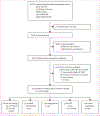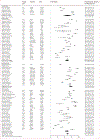HIV testing and engagement with the HIV treatment cascade among men who have sex with men in Africa: a systematic review and meta-analysis
- PMID: 31601542
- PMCID: PMC6993044
- DOI: 10.1016/S2352-3018(19)30239-5
HIV testing and engagement with the HIV treatment cascade among men who have sex with men in Africa: a systematic review and meta-analysis
Abstract
Background: HIV disproportionately affects gay, bisexual, and other men who have sex with men (MSM) in Africa, where many countries criminalise same-sex behaviour. We assessed changes in the engagement of African MSM with HIV testing and treatment cascade stages over time, and the effect of anti-LGBT legislation and stigma.
Methods: We systematically searched Embase, Global Health, MEDLINE, Scopus, and Web of Science for peer-reviewed cross-sectional or longitudinal studies recruiting at least ten MSM, published from Jan 1, 1980, to Oct 10, 2018. We extracted or derived estimates of HIV testing, engagement with the HIV treatment cascade, or both among African MSM from published reports. We derived pooled estimates using inverse-variance random-effects models. We used subgroup and meta-regression analysis to assess associations between testing and status awareness outcomes and study and participant characteristics, including the severity of country-level anti-LGBT legislation.
Findings: Our searches identified 75 independent eligible studies that provided estimates for 44 993 MSM across one or more of five testing and treatment cascade outcomes. HIV testing increased significantly over time overall, with pooled proportions of MSM ever tested for HIV of 67·3% (95% CI 62·1-72·3; 44 estimates) and tested in the past 12 months of 50·1% (42·4-57·8, 31 estimates) after 2011, which were 14·8 percentage points and 17·9 percentage points higher than before 2011, respectively. After 2011, ever testing was highest in southern Africa (80·0%), and lowest in northern Africa (34·4%), with the greatest increase in western Africa (from 42·4% to 70·9%). Levels of testing ever, in the past 12 months, and status awareness were statistically significantly lower in countries with the most severe anti-LGBT legislation compared with countries with the least severe legislation (57·4% vs 71·6%, p=0·0056; 35·5% vs 49·3%, p=0·010; 6·7% vs 22·0%, p=0·0050). Few estimates were available for later stages of the treatment cascade. Available data after 2011 suggest that the pooled proportion of MSM HIV-positive aware has remained low (18·5%, 12·5-25·3; 28 estimates), whereas proportions of current antiretroviral therapy (ART) use were 23·7% (15·5-33·0; 13 estimates) among all MSM living with HIV and 60·1% (48·6-71·1; five estimates) among MSM HIV-positive aware of their status. Pooled levels of viral suppression among MSM currently on ART were 75·6% (64·4-85·5; four estimates), but only 24·7% (18·8-31·2; four estimates) among all MSM living with HIV.
Interpretation: Despite improvements in HIV testing among MSM in Africa, HIV status awareness, ART coverage, and viral suppression remain much lower than required to achieve UNAIDS 90-90-90 targets. Further studies are urgently needed to provide more accurate estimates of levels of status awareness, engagement in care, ART coverage, and viral suppression among MSM to inform prevention efforts aimed at improving access to HIV services for MSM. Severe anti-LGBT legislation might be associated with lower HIV testing and status awareness; therefore, further research is needed to assess the effect of such legislation on HIV testing and engagement with the HIV treatment cascade among MSM.
Funding: US National Institutes of Health, UK Medical Research Council.
Copyright © 2019 Elsevier Ltd. All rights reserved.
Figures








Comment in
-
Men who have sex with men: a key population in Africa.Lancet HIV. 2019 Nov;6(11):e728-e729. doi: 10.1016/S2352-3018(19)30265-6. Epub 2019 Oct 7. Lancet HIV. 2019. PMID: 31601546 No abstract available.
References
-
- HIV.gov. Policies and issues: HIV care continuum. 2016. https://www.hiv.gov/federal-response/policies-issues/hiv-aids-care-conti... (accessed June 10, 2019).
-
- UNAIDS. Miles to go: closing gaps breaking barriers righting injustices. 2018. https://www.unaids.org/sites/default/files/media_asset/miles-to-go_en.pdf (accessed June 10, 2019)
Publication types
MeSH terms
Substances
Grants and funding
LinkOut - more resources
Full Text Sources
Medical
Miscellaneous

